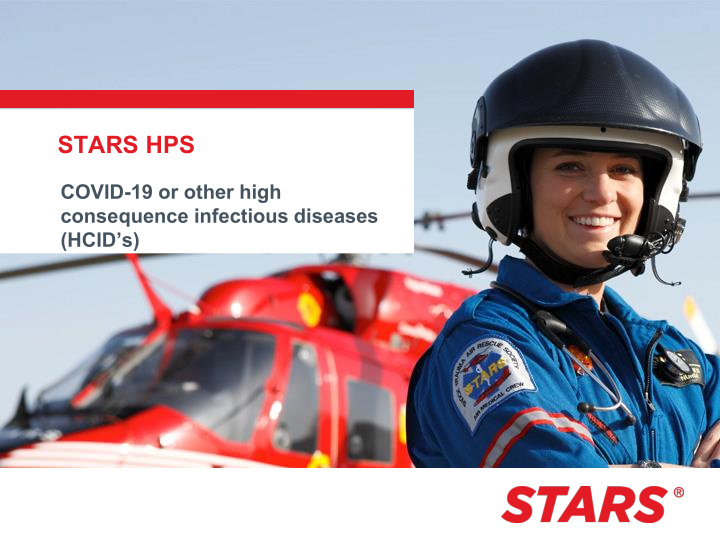



STARS HPS COVID-19 or other high consequence infectious diseases (HCID’s)
DISPATCH CALL • IFT to a facility which is an approximately 30-minute flight • The patient is a 65-year old male who is suffering hypoxemic respiratory failure secondary to presumed infection with the novel coronavirus (SARS-CoV-2 which causes COVID-19) • Fevers, chills, cough and a sore throat which has been progressive over the past 2-3 days • His GCS is currently 15 and his vitals are as follows: • T 38; P 121; RR 40; BP 124/79; O 2 sats – 76% on room air (94% on 15L by prongs AND 15L by NRB); BGL 7.6
DISPATCH CALL continued • Initial VBG (on O 2 ) from facility – pH 7.45 – pCO 2 39 – pO 2 50 – HCO 3 25 – TCO 2 26 – sO 2 80 – Lac 1.8
AMC arrival at Hospital • Patient seems to have deteriorated – GCS now 13-14 (E4, V4, M5-6) – Vitals: HR 125, BP 120/75, RR 30, SpO2 89% on 15L NP and 15L NRB – repeat VBG next slide 10
ISTAT Venous CG4+ 7.20 40 34 -5 18 19 60 5.9 12
.
LABORATORY RESULTS FROM HOSPITAL • Hgb 143 • Plt 299 • WBC 10.6 • Lymph 0.7 • Glucose 7.6 • 130 ↓ Na • 3.1 ↓ K • 94 ↓ Cl • Creatinine 68 • Urea 5.4 • Troponin 10 10 • 1.17 ↑ D-Dimer
. 11
ISTAT VENOUS CHEM 8+ 7.6 5.4 131 68 3.1 0.45 94 149 1.09 21 20 13
DEBRIEFING • What went well? • What else happened? • How did the team function? • How will you apply what you learned to the clinical setting? 14
TEACHING SLIDE 1. Donning/Doffing PPE 2. Communication with PPE 3. Airway management in a patient with a highly infectious respiratory pathogen such as SARS-CoV-2 which causes COVID-19 Note: D-dimer often elevated in COVID-19 patients – this is used for prognostication and research purposes. Do not initiate PE work-up unless clinically indicated. 16
Recommend
More recommend